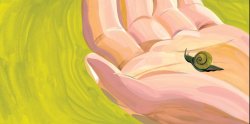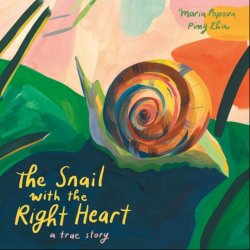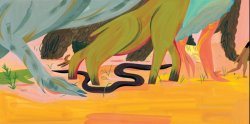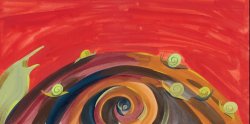
Artwork by Ping Zhu from The Snail with the Right Heart: A True Story © 2021 by Enchanted Lion Books


Reviewed By Maughn Rollins Gregory
Not many years ago, a retired scientist from London’s Natural History Museum noticed a garden snail with a shell that spiraled left to right—the opposite direction from others of its species. He delivered the singular creature to Angus Davidson, Professor of Evolutionary Genetics at the University of Nottingham, who had never seen a “lefty” snail before, and jokingly named this one Jeremy, after the left-wing politician Jeremy Corbyn. Jeremy-the-snail’s condition is known as situs inversus, Latin for “inverted internal organs,” meaning that not only did Jeremy have a reversed shell, but internal organs arranged on the opposite side from other snails, including a heart on the right side of its body—a condition rarer than one in a million. Humans are symmetrical on the outside but asymmetrical on the inside, and Maria Popova was inspired to write this story because of her relationship with “a beloved young human in my own life, who is living with the same rare and wondrous variation.”
To study Jeremy’s genes, Davidson needed to help the right-hearted snail reproduce—something nearly impossible, because Jeremy could only mate with other snails with reproductive organs on the “wrong” side of their bodies. So, Davidson went on BBC Radio to ask citizen-scientists around the world to look for other lefty snails. Within a month, one was found in England and another in Spain. Jeremy eventually mated with the Spanish snail, producing 56 babies—none of which had left-spiraling shells. The story concludes that the recessive gene responsible for Jeremy’s variation “had once again become a dormant seed in the garden of life. But somewhere, in some future garden, it will bloom again.”

Artwork by Ping Zhu from The Snail with the Right Heart: A True Story © 2021 by Enchanted Lion Books
Genetics and Identity
In order to understand Jeremy’s story, we have to understand the process of genetic reproduction. In doing so, we come to see that our own genetic traits shape our individuality and our relationship to family members and others in the concentric ripples of our gene pool. Scientists today ask questions about how much of our personhood is caused by our genes—besides our height and eye color, what about our ways of thinking, our emotional reactions, our tastes and preferences, and other personality quirks? How much of who I am was decided by my genes, how much by how I was brought up and educated, and how much by my own choices? How much of who I am can only be understood in the longer story—much longer than my own life—of where I came from?
Sex, Gender, and Love
In order to understand Jeremy’s story, we also have to understand that genes are “planted” in each new generation through biological reproduction. Popova explains that reproduction may be sexual or asexual, and that some species, like snails, can reproduce in both ways: “If a [snail] makes babies alone, they are almost exactly like their parent. But when two parents make a baby together, the baby is partly like each of them.” What’s more, any two snails can mate together, because “One of the wonders of snails is that […] every snail has a body that is both male and female. Such a wondrous body is called a hermaphrodite.” This is why, “although Jeremy the snail was given a boy name, Jeremy the snail was neither a he nor a she. Jeremy—like all land snails—was a they.”
The biological facts of asexual reproduction and of intersex species and individuals—including humans—have become the stuff of science fiction thought experiments. But these facts should also provoke philosophical questions about the “naturalness” of sexual and gender diversity across human cultures of various times and places.

Artwork by Ping Zhu from The Snail with the Right Heart: A True Story © 2021 by Enchanted Lion Books
Evolution, Mutation, and Diversity
In order to understand Jeremy’s story, we also have to understand how random genetic mutation drives biological diversity. For this reason, Popova situates Jeremy’s story in geologic time, beginning “long ago, before half the stars that speckle the sky were born.” She recounts the beginning and the diversification of biological life on Earth—vividly depicted in Ping Zhu’s artwork—in which snails appeared hundreds of millions of years before humans.
Being confronted with this scale of time prompts us to take a philosophical step backward. How is what it means to be human altered by this perspective of our species as a relative newcomer in the story of life, and as just one among millions of others that have co-evolved over millennia? Should we, as environmental biologist Robin Wall Kimmerer urges, think not of a hierarchy but of a democracy of species? And if evolution will continue as long as biological life continues, what might be the next chapter in the story of our species?

Artwork by Ping Zhu from The Snail with the Right Heart: A True Story © 2021 by Enchanted Lion Books
Popova’s descriptions of genetic differences are intentionally appreciative. The man who notices Jeremy’s left-spiraling shell wonders, “Maybe its strangeness held some beautiful secret waiting to be unlocked.” The bodies of hermaphrodite snails and situs inversus humans are “wondrous.” The story of life on Earth begins with “a change so mysterious and magnificent that it was given a special name: mutation.” And Popova remarks that “diversity is always lovelier than sameness.” There is no mention of deformity, defect, abnormality, or mistake.
But we can, and should ask: What genetic traits—height, weight, skin color, hair color and texture, dis/ability, gender, sexual orientation, reproductive health—make life easier or more difficult in our community and our broader society? What mental traits, including creativity, learning dis/abilities, and neurodiversity? What non-genetic factors, such as religion, first language, ethnic heritage, gender expression, occupation, and wealth? Human communities in different times and places have gone to great lengths to protect and accommodate certain kinds of differences, while discouraging and even punishing others. How should our community deal with these and other kinds of dramatic differences from the normal?
Science and Community
The American philosopher Charles Peirce observed over a hundred years ago that science and philosophy require “communities of inquiry.” Jeremy’s story shows how sometimes, science needs not only a community of scientists but a community of professional and citizen scientists, including children. In fact, in the three years following the story told here, citizen-scientists and snail farmers sent 40 more lefty snails to Davidson’s team, who helped them mate with Jeremy’s children, hatching nearly 15,000 more offspring. Davidson’s team credited “‘Jeremy the snail’ citizen scientists” as contributors to the study they published in 2020.
Human communities—of inquiry, art, politics, education, cooking—draw out and draw on the peculiar talents of their members. How many different communities do you and I belong to? What do we contribute to them? How do these communities support us in—or hinder us from—becoming a better you and me? Most species of plants and animals also form biological communities, in which there are diverse roles and responsibilities. And many species—humans in particular—cooperate with other species. When humans cooperate with honeybees, dairy cows, or tomatoes, what kinds of benefits and detriments occur to each side?
It’s not a coincidence that philosophy—not only in the West—began as inquiry about nature. And as this story illustrates, modern science is brimming with philosophical concepts and perplexities.

Artwork by Ping Zhu from The Snail with the Right Heart: A True Story © 2021 by Enchanted Lion Books
References
Davidson, Angus (2020) Experience: I helped a snail find love. The Guardian, 14 August 2020.
Retrieved 29 July 2023 from
https://www.theguardian.com/lifeandstyle/2020/aug/14/experience-i-helped-a-snail-
find-love.
Davison, Angus, Thomas Philippe and ‘Jeremy the snail’ citizen scientists (2020) Internet
‘shellebrity’ reflects on origin of rare mirror-image snails. Biology Letters 16(6).
Retrieved 29 July 2023 from
https://royalsocietypublishing.org/doi/full/10.1098/rsbl.2020.0110.
Kimmerer, Robin Wall (2021) Braiding Sweetgrass: Indigenous Women, Scientific Knowledge,
and the Teachings of Plants. Milkweed Editions.
Popova, Maria (2021b) The Snail with the Right Heart: A true story of science and love.
Retrieved 29 July 2023 from https://www.themarginalian.org/2021/01/02/the-snail-
with-the-right-heart/.